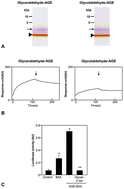Low-molecular weight fractions of Japanese soy sauce act as a RAGE antagonist via inhibition of RAGE trafficking to lipid rafts†
Abstract
Advanced glycation end-products (AGE) have been implicated in aging and the pathogenesis of diabetic complications, inflammation, Alzheimer's disease, and cancer. AGE engage the cell surface receptor for AGE (RAGE), which in turn elicits intracellular signaling, leading to activation of NF-κB to cause deterioration of tissue homeostasis. AGE are not only formed within our bodies but are also derived from foods, endowing them with flavor. In the present study, we assessed the agonistic/antagonistic effects of food-derived AGE on RAGE signaling in a reporter assay system and found that low-molecular weight AGE can antagonize the action of AGE-BSA. Foods tested were Japanese soy sauce, coffee, cola, and red wine, all of which showed fluorescence characteristics of AGE. Soy sauce and coffee contained Nε-carboxymethyl-lysine (CML). Soy sauce, coffee, and red wine inhibited the RAGE ligand-induced activation of NF-κB, whereas cola had no effect on the ligand induction of NF-κB. The liquids were then fractionated into high-molecular weight (HMW) fractions and low-molecular weight (LMW) fractions. Soy sauce-, coffee-, and red wine-derived LMW fractions consistently inhibited the RAGE ligand induction of NF-κB, whereas the HMW fractions of these foods activated RAGE signaling. Using the LMW fraction of soy sauce as a model food-derived RAGE antagonist, we performed a plate-binding assay and found that the soy sauce LMW fractions competitively inhibited AGE-RAGE association. Further, this fraction significantly reduced AGE-dependent monocyte chemoattractant protein-1 (MCP-1) secretion from murine peritoneal macrophages. The LMF from soy sauce suppressed the AGE-induced RAGE trafficking to lipid rafts. These results indicate that small components in some, if not all, foods antagonize RAGE signaling and could exhibit beneficial effects on RAGE-related diseases.

- This article is part of the themed collection: The Maillard reaction in food and nutrition

 Please wait while we load your content...
Please wait while we load your content...